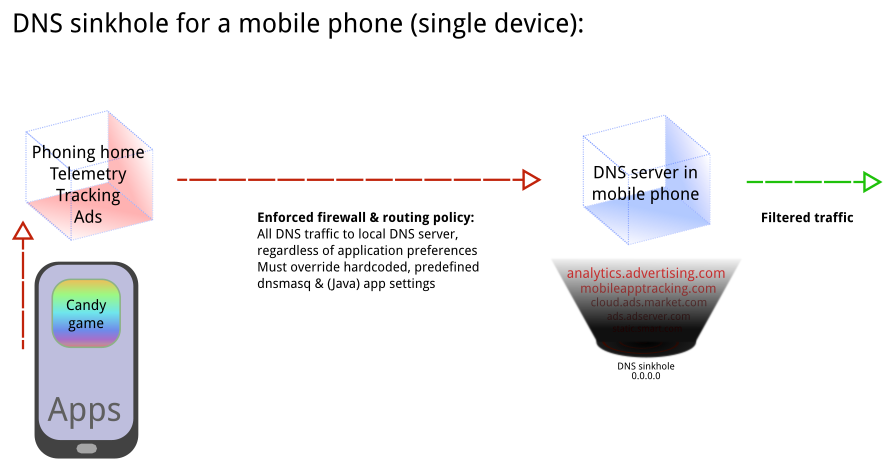|
|
5 years ago | |
|---|---|---|
| data | 5 years ago | |
| images | 5 years ago | |
| LICENSE | 5 years ago | |
| README.md | 5 years ago | |
README.md
DNS sinkhole
Generate domain sinkhole (blacklist) files for DNSCrypt and pdnsd DNS servers. Comparable to Pi-Hole, but uses more simple structure without too much overhead. Generated blacklist files can be added to existing DNS server installations.
Usage
Add blacklists and whitelists as you wish into the python script. Once done, run the script with Python 3. The script generates necessary files for you to adapt to your DNS servers.
Developer's notice
Benefits:
Useful for blocking ads, tracking & telemetry on:
-
single device with a DNS server
-
on a full network segment if a centralized DNS server is used (multiple devices)
-
applies to IoT devices (+ SmartTVs etc.) if traffic is routed via a centralized DNS server applying this sinkhole/blacklist policy
NOTE (Tor users): These lists do not work with SOCKS5/HTTP Tor connections, as DNS resolution is done on the Tor exit nodes, not by your DNS server(s).
NOTE: This method may not work if device's hosts file is modified so that it overrides accepted DNS policy.
Tested on
Arch Linux (x86_64): DNSCrypt server, pdnsd server
Android (mobile phone, ARMv7): DNSCrypt server
About used list formats
pdnsd
Although pdnsd offers neg feature, it is not very reliable with large DNS blocklists. However, custom rr (Resource Record) entries have been tested with a list of over 240 000 blacklisted domains, and it works as expected.
DNSCrypt
Although DNSCrypt offers blacklist feature, it is not very reliable with large DNS blocklists. However, cloaking list has been tested with a list of over 240 000 blacklisted domains, and it works as expected.
Basic principle/idea
Single device
Multiple devices
Detecting malicious network traffic on Android & (embedded) IoT devices
Network analysis is strongly encouraged for mobile phones and (embedded) IoT devices to detect malicious or unwanted connections which are usually taking place without user's knowledge. You can use results of the analysis to build your own DNS sinkhole blacklist for devices or network segments.
You can use tcpdump or wireshark for network analysis purposes.
Mobile phones: you may consider limiting count of installed applications. More applications you have, more unwanted network traffic may occur.
Be aware that some applications or websites may break if too greedy policy is taken in place. DNS sinkhole works at best with combination of other network filtering/firewall policy applied, as well (application & network/data link layers). Understanding OSI model and/or TCP/IP protocol stack helps you to build a proper policy for your network devices.
Why not just a simple hosts file??
Of course, you can apply DNS sinkhole list to your device's hosts file (Linux: /etc/hosts, Android: /system/etc/hosts, Windows: C:\Windows\System32\Drivers\etc\hosts). However, there are some benefits and some drawbacks:
Benefits of hosts:
-
Simple setup: no software installation or compilation
-
No DNS server required: thus no extra configuration/software overhead or server-specific security risks
Drawbacks of hosts:
-
Does not scale: does not apply to a network segment or segments for which you want to block specific domain names. Applies only to single devices.
-
No extra security, such as enforced DNS-over-HTTPS*, proxy configurations** or DNSSEC*** verification, provided by a properly configured DNS server
* By default, domain name lookups are done via UDP port 53, and DNS queries are unencrypted. Thus, anyone between you and the DNS server can read the domain name lookups your applications request. With DNS-over-HTTPS, all DNS queries are wrapped in encrypted packets, sent through TCP port 443 and thus making your DNS queries unknown by others excluding you and the DNS server.
** You can enforce DNS queries through a proxy, such as via a server of your choise or via Tor network
*** You can set-up DNS server of your choice to use enforced DNSSEC policy. In other words, if a rogue DNS server to which your DNS query (domain name lookup) is pointed to, breaks DNSSEC chain, the query is being left unanswered.
License
This repository uses MIT license. See LICENSE file for details.


